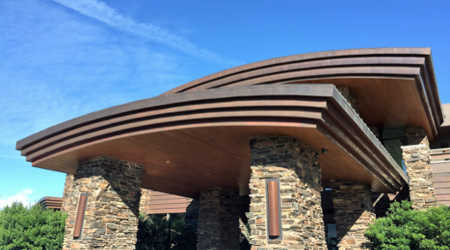« Back to Facilities Management Roofing Category Home
Have You Ever Considered a Copper Roof?
January 4, 2018
- Roofing
If you’ve ever seen a classic domed cathedral, a cupola atop a courthouse, you’ve seen the beauty and versatility of copper used in roofing and architecture. Perhaps you’ve been entranced by a modern building with twisting and shining copper panels and admired the grace and beauty of the classic metal incorporated into the building design. Copper is not only an artistic metal for public spaces, it is in increasing use for homes and office buildings as well.
The Benefits of a Copper Roof
Copper has many advantages that make it an excellent building material, including malleability, durability, light weight, longevity, reflectivity, and rust and weather resistance.
Beauty and Flexibility
Copper’s natural color, shine, warmth and texture make a well-designed and expertly installed copper roof a thing of beauty in itself. As a relatively soft metal, with great ductility and malleability, copper can easily be worked into customized shapes to cover domes, towers, arches, gables and other structural features.
Over time, natural weathering, called patina, will transform the color of a copper roof from the original shiny-penny copper color to a subtle and attractive bluish-green. This process can be slowed or speeded up, depending on the building owner’s preference. Often, the classic patina is a desired effect to match a renovated traditional or classic architectural style, whereas the shine and glow of unweathered copper may better suit very modern architectural styles.
Practicality and Efficiency
In addition to its intrinsic attractiveness, copper roofing and panels provide exceptional durability and energy efficiency, while requiring a minimum of maintenance. Copper is a superb reflector of the rays of the sun, which is a crucial aid to cooling buildings and reducing energy costs. A good insulator, it will retain warmth inside the home during winter, lowering energy bills year round.
Copper is also a very light metal, making it relatively inexpensive to transport and install. This lightness also brings the benefit of significantly reducing the stress placed on the supporting walls of your home when compared with other options such as steel or concrete tiles.
Unlike many other metal roof options, copper can stand alone without painting or coating and it’s immune to rust and corrosion. A copper roof is mildew resistant, and will not rot, crack, split, leak or suffer from the invasion of rodents or termites.
Sustainability of Copper
Metal roofs, including copper ones, are typically made of a minimum of 30% recycled materials, more commonly at least 75%, and are 100% recyclable at the end of their useful life. The total amount of recycled copper used annually in the USA is equivalent to the amount of the newly mined metal, making copper an environmentally wise choice. A copper roof will typically last 50 to 100 years or more, with minimum care and general maintenance.
Weather and Fire Resistance
Copper is amongst the most highly weather resistant of all roofing materials and can be designed and installed to withstand extremes of climate, particularly including strong winds and extreme heat. it also works well in regions prone to heavy snowfalls. Copper roofs will never burn, and will in fact retard the spread of a fire. They are also naturally resistant to mold, extreme rain, hail and even earthquakes and hurricanes. For this reason metal roofs, including copper, are recommended by the Federal Emergency Management Agency (FEMA) for areas particularly subject to these kind of disasters. Copper is growing in popularity in Florida and other parts of the Southeast where hurricanes are most likely to occur.








